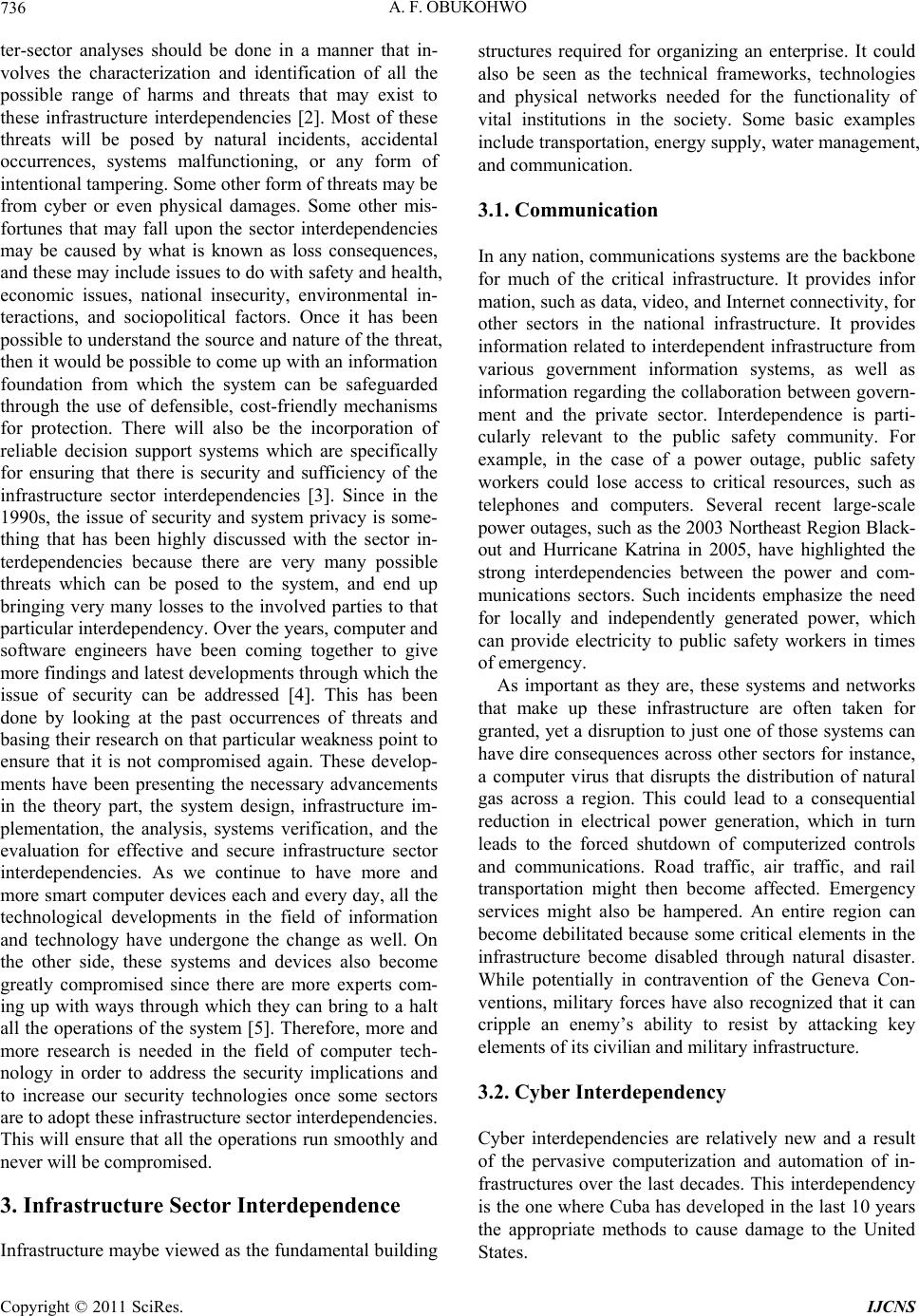
A. F. OBUKOHWO
736
ter-sector analyses should be done in a manner that in-
volves the characterization and identification of all the
possible range of harms and threats that may exist to
these infrastructure interdependencies [2]. Most of these
threats will be posed by natural incidents, accidental
occurrences, systems malfunctioning, or any form of
intentional tampering. Some other form of threats may be
from cyber or even physical damages. Some other mis-
fortunes that may fall upon the sector interdependencies
may be caused by what is known as loss consequences,
and these may include issues to do with safety and health,
economic issues, national insecurity, environmental in-
teractions, and sociopolitical factors. Once it has been
possible to understand the source and nature of the threat,
then it would be possible to come up with an information
foundation from which the system can be safeguarded
through the use of defensible, cost-friendly mechanisms
for protection. There will also be the incorporation of
reliable decision support systems which are specifically
for ensuring that there is security and sufficiency of the
infrastructure sector interdependencies [3]. Since in the
1990s, the issue of security and system privacy is some-
thing that has been highly discussed with the sector in-
terdependencies because there are very many possible
threats which can be posed to the system, and end up
bringing very many losses to the involved parties to that
particular interdependency. Over the years, computer and
software engineers have been coming together to give
more findings and latest developments through which the
issue of security can be addressed [4]. This has been
done by looking at the past occurrences of threats and
basing their research on that particular weakness point to
ensure that it is not compromised again. These develop-
ments have been presenting the necessary advancements
in the theory part, the system design, infrastructure im-
plementation, the analysis, systems verification, and the
evaluation for effective and secure infrastructure sector
interdependencies. As we continue to have more and
more smart computer devices each and every day, all the
technological developments in the field of information
and technology have undergone the change as well. On
the other side, these systems and devices also become
greatly compromised since there are more experts com-
ing up with ways through which they can bring to a halt
all the operations of the system [5]. Therefore, mor e and
more research is needed in the field of computer tech-
nology in order to address the security implications and
to increase our security technologies once some sectors
are to adopt these infrastructure sector interdependencies.
This will ensure that all th e operations run smoothly and
never will be compromised.
3. Infrastructure Sector Interdependence
Infrastructure maybe viewed as the fundamental building
structures required for organizing an enterprise. It could
also be seen as the technical frameworks, technologies
and physical networks needed for the functionality of
vital institutions in the society. Some basic examples
include transportation, energy supply, water management,
and communication.
3.1. Communication
In any nation, communications systems are the backbone
for much of the critical infrastructure. It provides infor
mation, such as d ata, v ideo, an d In ternet co nn ectiv ity, fo r
other sectors in the national infrastructure. It provides
information related to interdependent infrastructure from
various government information systems, as well as
information regarding the collaboration between govern-
ment and the private sector. Interdependence is parti-
cularly relevant to the public safety community. For
example, in the case of a power outage, public safety
workers could lose access to critical resources, such as
telephones and computers. Several recent large-scale
power outages, such as the 2003 Northeast Region Black-
out and Hurricane Katrina in 2005, have highlighted the
strong interdependencies between the power and com-
munications sectors. Such incidents emphasize the need
for locally and independently generated power, which
can provide electricity to public safety workers in times
of emergency.
As important as they are, these systems and networks
that make up these infrastructure are often taken for
granted, yet a disruption to ju st one of those systems can
have dire consequences across other sectors for instance,
a computer virus that disrupts the distribution of natural
gas across a region. This could lead to a consequential
reduction in electrical power generation, which in turn
leads to the forced shutdown of computerized controls
and communications. Road traffic, air traffic, and rail
transportation might then become affected. Emergency
services might also be hampered. An entire region can
become debilitated becau se some critical elements in the
infrastructure become disabled through natural disaster.
While potentially in contravention of the Geneva Con-
ventions, military forces have also recognized that it can
cripple an enemy’s ability to resist by attacking key
elements of its civilian and military infrastructure.
3.2. Cyber Interdependency
Cyber interdependencies are relatively new and a result
of the pervasive computerization and automation of in-
frastructures over the last decades. This interdependency
is the one where Cuba has developed in the last 10 years
the appropriate methods to cause damage to the United
States.
Copyright © 2011 SciRes. IJCNS